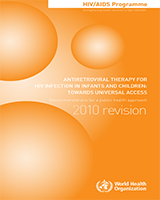All rights reserved. Publications of the World Health Organization can be obtained from WHO Press, World Health Organization, 20 Avenue Appia, 1211 Geneva 27, Switzerland (tel.: +41 22 791 3264; fax: +41 22 791 4857; e-mail: tni.ohw@sredrokoob). Requests for permission to reproduce or translate WHO publications – whether for sale or for noncommercial distribution – should be addressed to WHO Press, at the above address (fax: +41 22 791 4806; e-mail: tni.ohw@snoissimrep).
NCBI Bookshelf. A service of the National Library of Medicine, National Institutes of Health.
Antiretroviral Therapy for HIV Infection in Infants and Children: Towards Universal Access: Recommendations for a Public Health Approach: 2010 Revision. Geneva: World Health Organization; 2010.

Antiretroviral Therapy for HIV Infection in Infants and Children: Towards Universal Access: Recommendations for a Public Health Approach: 2010 Revision.
Show details15.1. Principles
- The physical and psychological changes associated with adolescence have implications for the provision of appropriate HIV treatment and care.
- WHO recommends that the choice of ART regimen and dosages for adolescents be based on sexual maturity rating.
- The use of EFV and NVP in adolescent girls requires special clinical considerations.
- Adherence to long-term therapy is particularly difficult among adolescents, and education and provision of support systems may be most effective if specifically tailored to the considerations relevant to this age group.
15.2. Background
WHO considers adolescence as the period between 10 and 19 years of age, during which healthy adolescents pass through well-described stages of physical, psychological and sexual maturation. These have implications for the provision of appropriate treatment and care for HIV-infected adolescents.
There are distinct groups of HIV-infected adolescents who may require ART: adolescents with long-standing HIV infection who were infected around birth and survived, and those who become infected during adolescence. Adolescents with long-standing HIV infection who began ART during early childhood have typically had many years of contact with the health system and are likely to have experienced various ART regimens. In addition, their parents are often aware of their HIV status. In this group of adolescents, the challenges relate mainly to the following:
- disclosure of HIV status to them if this has not been done by their parents
- developmental delay
- the transition from paediatric to adult care, including the choice of appropriate ART regimens
- adherence [7].
HIV-infected adolescents with long standing HIV infection often face considerable physical challenges. They may experience delayed growth and development, often resulting in late puberty and, in girls, delayed or irregular menstrual cycles [202]. Stunting and/or wasting caused by progressing HIV illness, frequently exacerbated by malnutrition, may further complicate decision-making on whether to follow ART guidelines for adults or children.
15.3. Regimens and dosing
WHO recommends basing the choice of ART regimen and dosages for adolescents on sexual maturity rating (i.e. Tanner staging, Annex H): adolescents in Tanner stage I, II or III should be started on the paediatric schedule and monitored with particular care because they are undergoing hormonal changes associated with the growth spurt. Adolescents in Tanner stage IV or V are considered to be adults and the same recommendations and special considerations apply as for adults [203].
However, in choosing an appropriate ART regimen and dosages, it is necessary to go beyond the consideration of maturity. Simplification of treatment regimens and anticipated long-term adherence are also important criteria. Other considerations relate to the use of EFV and NVP in adolescent girls. EFV should not be used in adolescent girls who are at risk of becoming pregnant (i.e. are sexually active and not using adequate contraception) or those in the first trimester of pregnancy. Symptomatic NVP-associated hepatotoxicity or serious rash, while uncommon, is more frequent in females than in males, and is more likely to be seen in ARV-naive females with higher absolute CD4 cell counts (>250 cells/mm3). NVP should therefore be used with caution in adolescent girls with absolute CD4 counts between 250 and 350 cells/mm3. If used in such adolescent girls, careful monitoring, preferably including liver enzymes, is needed during the first 12 weeks of therapy. In situations where both EFV and NVP are contraindicated in first-line regimens for adolescent girls, the use of a triple NRTI regimen may be indicated.
15.4. Adherence for adolescents
Adherence to long-term therapy is particularly difficult among adolescents. In addition to providing routine adherence assessment and support (see Chapter 16), health-care providers should consider issues which are particularly relevant to adolescents and which may impair optimal adherence to ART. These include the possible perception of adolescents of being immortal, their desire for independence, lack of disclosure of HIV status and stigma. The parents of adolescents who have become infected as infants or young children may find it hard to share the diagnosis of HIV with their children because of fear of stigma or blame from their own children. However, without this knowledge, it is impossible for adolescents to progress completely through the transition process into adult care. Sharing this diagnosis with peers is difficult for adolescents who are aware of their HIV status [204].
15.5. Summary
For these reasons, it is especially important that young people [205]:
- are informed about their HIV status
- are well educated about their condition, its treatment and the importance of adhering to care and ART
- are confident of their ability to talk about HIV with those whom they want to share knowledge of their condition with
- have a support system so that they know where to obtain help and advice when necessary.
- CONSIDERATIONS FOR ART IN ADOLESCENTS - Antiretroviral Therapy for HIV Infection...CONSIDERATIONS FOR ART IN ADOLESCENTS - Antiretroviral Therapy for HIV Infection in Infants and Children: Towards Universal Access
Your browsing activity is empty.
Activity recording is turned off.
See more...